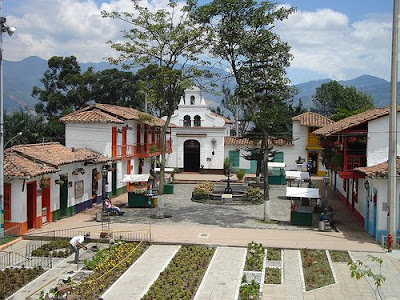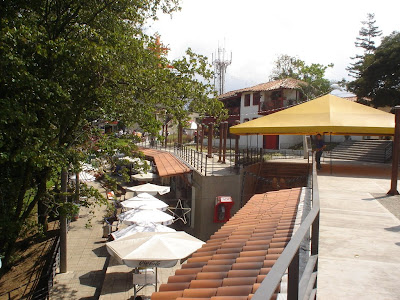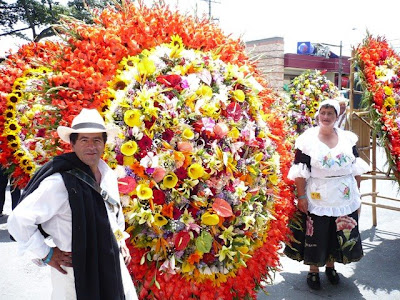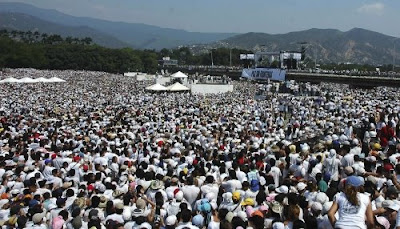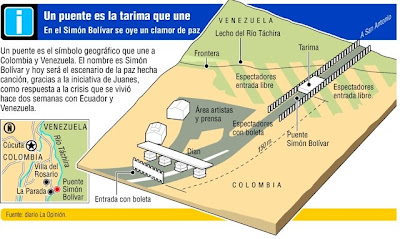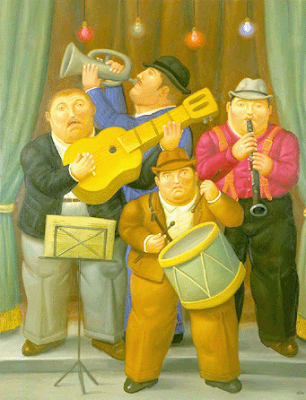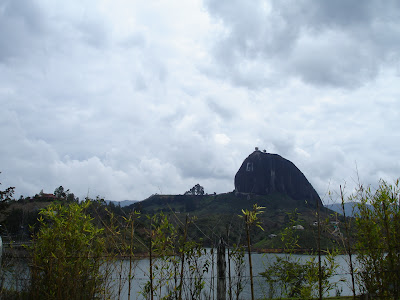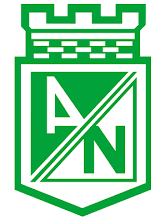The party was off to a raucous start. A chorus of whoops and yelps from the crowd followed a loud “Buenas noches!” from the M.C. A band played traditional Colombian music. Liberal pourings of rum and Cokes helped lubricate the festivities.
The party, held on a drizzly Friday night, was bouncing — literally. “I’ve got to be careful when the potholes hit,” said Raul Alphavitae, 28, one of the musicians with the band, Aires del Folklor.
Mr. Alphavitae’s observation gives a hint of what made this night on the town a little different: The party was held on wheels, in an old yellow school bus decked out in yellow, red and blue paint. “We’re like musical ninjas — we have to stay on balance while everything is bouncing around,” Mr. Alphavitae said.
As New York City’s Colombian population has ballooned, one custom that has been transplanted is the use of rustic buses, or chivas as they are called in Spanish, for parties.
 A chiva in Medellin, Colombia
A chiva in Medellin, Colombia“By the time the bus crosses the bridge, everybody is friends,” said Sorady Cortes, 28, a physical therapist out with some girlfriends, as she waited for the chiva to start its engine in Queens and head west over the Queensboro Bridge and into Midtown Manhattan. “They have a bar, and that helps.”
In the chiva, partygoers seeking a more authentic taste of Colombia poured aguardiente, an anise-flavored liquor, from a wineskin. Some of the roughly 30 people on the tour donned traditional Colombian straw hats called sombreros vueltiaos, and shook maracas and tambourines to get the party started. The M.C. worked an iPod full of cumbia, salsa and reggaetón favorites while the band took a break.
Inside the packed bus, the seats along the sides were covered in burlap, a multicolored strobe light flickered, a smoke machine puffed and a small flat-panel television showed videos of gyrating dancers moving to a Latin beat. The operator of the chiva, Jean Carlos Balcazar, 26, said he had bought the 1985 Ford bus on eBay for $5,000.
But Mr. Balcazar’s isn’t the only chiva game in town. Daniel Bernal, 51, has a chiva in Dix Hills, on Long Island, that he uses to take groups to bars in the city and around the island. Mr. Bernal’s most vivid memory is of taking a bachelorette party to Hogs and Heifers, a drinking spot in the meatpacking district. When the women returned to the chiva, they continued the Hogs and Heifers tradition of doffing their bras in drunken abandon. “I kept my eyes on the road,” Mr. Bernal said.
Carmen Hernandez, 60, is considered the grande dame of chivas in New York. She began her company in 1986 with her husband and their eldest son. “The only thing I didn’t see in New York were chivas,” said Ms. Hernandez, who was a lawyer in her native Colombia. She said she sold her jewelry and used her savings to buy an old school bus in the Bronx, which served as her first chiva.
She now owns two chivas and employs 10 people, including drivers, D.J.’s, tour guides and security staff, for her “traveling discothèque.”
Mr. Bernal and Ms. Hernandez occasionally work together when they need extra chivas for larger groups. Between them, they said they have provided chivas for Don King, the national Colombian soccer team, Colombian beauty queens, and Drew Barrymore, Lucy Liu and Cameron Diaz for the New York premiere of “Charlie’s Angels.”
Although several chivas are operating in New York, there seems to be enough business to go around. The tours have similar options, like unlimited drinks and music, a stop at a Colombian restaurant for arepas (cornmeal patties) and other snacks, a stop at Rockefeller Plaza for a group photo and entry to a nightclub at the end of the tour.
The cost depends on the operator and whether the passengers want food, a live band or to go to a club. On one tour, the price is $40 a person for the night; on another, a group can pay $150 an hour. A chiva operator needs a valid commercial driver’s license and a permit to serve alcohol.
Outside Colombia, chivas had one of their biggest moments in the spotlight in the 1984 movie “Romancing the Stone,” when Kathleen Turner boarded one replete with chickens, pigs and farmers on an ill-fated ride through the Colombian mountains.
In fact, chivas are still the traditional mode of transportation in rural Colombia. But in cities like Medellín, Cali and Barranquilla, they are now used as party buses. The word chiva in Spanish means many things, including kid goat, and how it became the name of the brightly colored buses is anyone’s guess, Ms. Hernandez said. Some say that waiting passengers confused the bus with a goat from a distance. Others say the sound of the bus’s horn mimics that of a goat.
The word chiva is also slang for news. The buses were a way for families spread out in rural communities to stay in touch. Families would pass on messages like, “Tell my grandmother I’m O.K.,” said Francisco Noguera Rocha, the consul general for Colombia in New York.
Back on Mr. Balcazar’s tour, the brightly colored chiva was rocking through Times Square, and the music was booming. Onlookers waved and smiled. Tourists snapped photos. Pedicab drivers tooted their horns. The attention made the party hop even more. “I love the way people look, like, ‘We could be in there!’ ” said Michael Trujillo, 31, a passenger. “It’s an exclusive V.I.P. party without the velvet rope.”
The New York Times By TANZINA VEGA - Published: March 2, 2008



